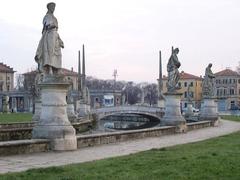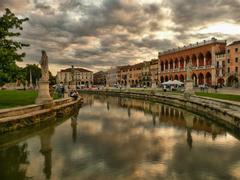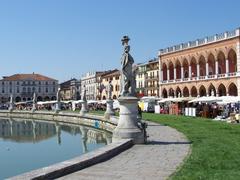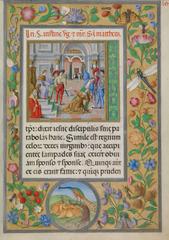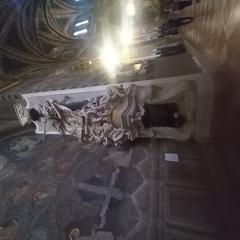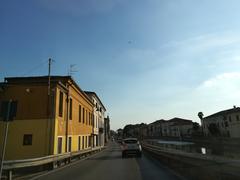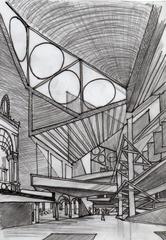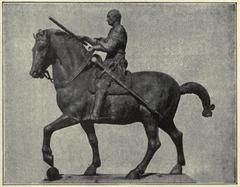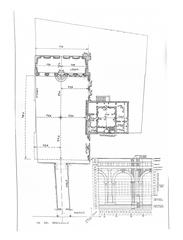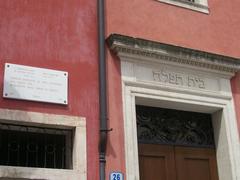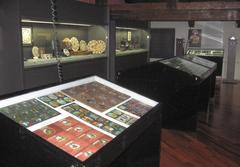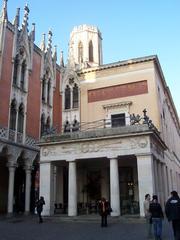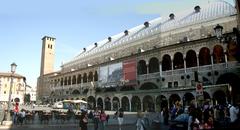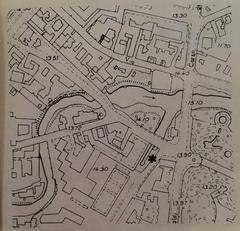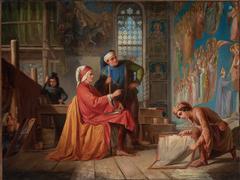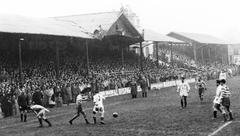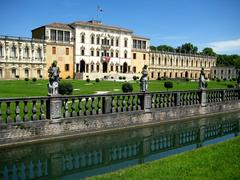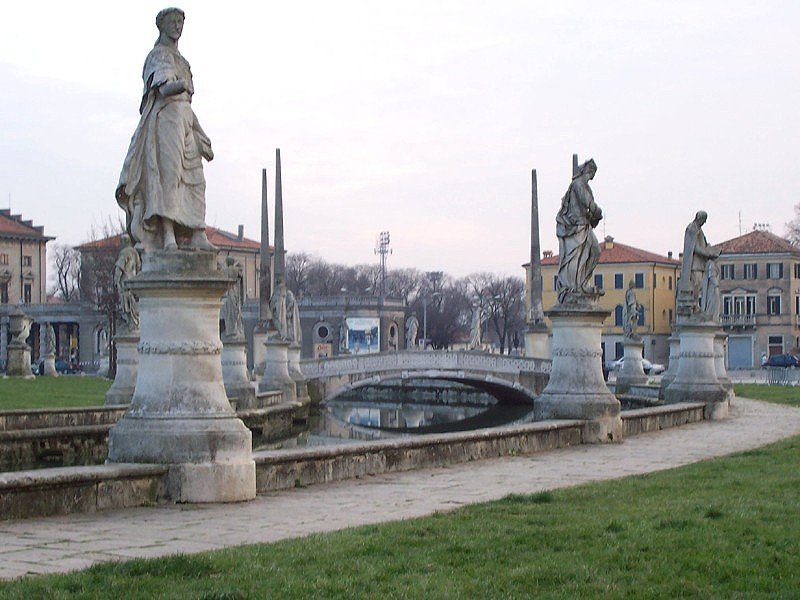
Prato della Valle: Visiting Hours, Tickets, and Comprehensive Guide to Padua’s Historical Square
Date: 14/06/2025
Introduction
Prato della Valle, located at the heart of Padua, Italy, is not only the country’s largest square but also ranks among Europe’s grandest public spaces. Its unique elliptical layout, historic statuary, and vibrant urban life have made it a symbol of Padua’s rich past and dynamic present. From its Roman origins to its 18th-century transformation by Andrea Memmo, Prato della Valle stands as a testament to centuries of civic vision, architectural ingenuity, and communal spirit (Turismo Padova, Nomads Travel Guide). This guide provides detailed information on visiting hours, ticketing, accessibility, history, nearby attractions, and practical tips for experiencing this remarkable site.
Table of Contents
- Introduction
- Historical Overview
- Layout and Urban Design
- Statue Ensemble and Artistic Features
- Architectural Landmarks
- Integration with Urban Life
- Practical Visitor Information
- Nearby Attractions
- Photography and Visual Opportunities
- Weather and Seasonal Considerations
- Visitor Etiquette
- FAQ
- Conclusion and Recommendations
- References
Historical Overview
Ancient and Roman Origins
The area of Prato della Valle has been a key gathering place since Roman times. It once hosted the grand Zairo Theatre and a hippodrome, serving as a vibrant center for entertainment and public events in ancient Padua. Archaeological finds during 18th-century construction confirmed its Roman legacy, highlighting the site’s longstanding importance (Turismo Padova).
Medieval and Early Modern Transformations
As the centuries passed, Prato della Valle continued to be central to Padua’s civic life. Medieval fairs, markets, and assemblies were commonplace, with historical records showing its use for significant public gatherings as early as 1077. The land was overseen by the Benedictine Abbey of Santa Giustina, shaping both its physical and cultural landscape. By the 17th century, the square had become a marshy, underutilized space, occasionally used for theatrical jousts and early public opera performances (Nomads Travel Guide).
Andrea Memmo’s Vision and the 18th-Century Renewal
The most significant transformation came in the late 18th century when Andrea Memmo, inspired to reclaim and revitalize the neglected area, initiated an ambitious urban renewal project. Under Memmo’s guidance and with engineering by Simone Stratico, the marshy land was drained, and the monumental Isola Memmia—an elliptical island surrounded by a canal—was created. This project not only beautified the area but also established it as a public space open to all, a progressive idea for its time. The new design featured a double ring of 78 statues, representing prominent figures from Padua’s history, and was soon flanked by elegant palazzi and significant religious buildings (Turismo Padova).
Layout and Urban Design
Prato della Valle covers approximately 90,000 square meters, boasting an elliptical layout bordered by a canal. At its center lies the Isola Memmia, accessible by four bridges and landscaped with lawns, trees, and pathways reflecting Enlightenment ideals of symmetry and order. The canal’s double ring, lined with 78 statues, creates a striking visual narrative, intertwining nature, water, and art (padua-erleben.de, ouritalianjourney.com).
Statue Ensemble and Artistic Features
The statues of Prato della Valle, crafted mainly from Istrian stone between 1775 and 1883, pay tribute to scholars, artists, political leaders, and benefactors, including Galileo Galilei and Andrea Memmo. Arranged to face both the city and the island, the statues foster a sense of dialogue between Padua’s illustrious past and its vibrant present. The neoclassical style, with its idealized forms and dignified poses, highlights the exceptional craftsmanship of local artists. Conservation projects continue to preserve this unique open-air gallery (padua-erleben.de).
Architectural Landmarks
Basilica of Santa Giustina
Dominating the southeastern edge of the square, the Basilica of Santa Giustina combines Romanesque origins with Renaissance grandeur. Its vast brick façade and domes house important artworks and relics, including the tomb of St. Luke the Evangelist (nomads-travel-guide.com).
Loggia Amulea
On the western side stands the neo-Gothic Loggia Amulea, built in the 19th century as the city’s fire brigade headquarters. Its pointed arches and decorative brickwork provide a picturesque counterpoint to the basilica and make it a favorite subject for photographers.
Historic Palazzi
The square is encircled by elegant palazzi from the 14th to 18th centuries, including the Palazzo Angeli—now home to the Museum of Precinema. These buildings, with their arcaded ground floors and stuccoed façades, reflect the area’s evolution into a hub of culture and civic life.
Integration with Urban Life
Prato della Valle is Padua’s social heart, affectionately called “Il Prato” by locals. It hosts bustling markets every Saturday, monthly antique fairs, and a variety of public celebrations, from New Year’s Eve fireworks to open-air concerts and student traditions. The square’s design accommodates these events while encouraging everyday activities like jogging, skating, and picnicking (Padova.com, Rossiwrites.com).
Practical Visitor Information
Visiting Hours and Ticketing
- Open hours: Prato della Valle is a public square open 24/7, year-round (thetouristchecklist.com).
- Entry fee: Free; no ticket required. Certain guided tours and special events may have fees—check local listings for details.
Accessibility
- Wheelchair and stroller access: The square features paved, level paths and ramps throughout, ensuring full accessibility.
- Lighting: Well-lit at night for safe evening visits.
Facilities and Amenities
- Restrooms: Public restrooms are located near the Basilica of Santa Giustina; cafés and restaurants nearby may also offer facilities.
- Seating and shade: Benches abound, and mature trees provide shaded areas, particularly on Isola Memmia.
- Food and drink: Many cafés, gelaterias, and restaurants line the square. Street food stalls appear during events and market days.
Events and Activities
- Saturday Market: One of Italy’s largest open-air markets, held every Saturday, with hundreds of stalls (myitaliandiaries.com).
- Carnival: Major festivities in early March, including parades and food stalls (turismopadova.it).
- Concerts, fairs, and open-air cinema: Held throughout the year; check the official tourism website for schedules.
Guided Tours
- Availability: Guided tours (typically €15–€25 per person) offer insights into history, art, and local traditions (misstourist.com).
- Booking: Recommended in advance, especially during peak seasons.
Safety and Regulations
- The square is safe and regularly patrolled by police.
- Dogs are permitted on leash; owners must clean up after their pets.
- Cycling and skating are allowed, but caution is advised during crowded times.
Travel Tips
- Visit early morning or late afternoon for fewer crowds and optimal photography.
- Spring and autumn provide mild weather and the most vibrant scenery.
- Wear comfortable shoes, bring water, and consider packing a picnic.
Nearby Attractions
- Basilica of Saint Anthony: Five minutes’ walk from the square (sacredwanderings.com).
- Orto Botanico di Padova: The world’s oldest university botanical garden and a UNESCO World Heritage site, five minutes away.
- Historic Center: Piazza delle Erbe, Piazza dei Signori, and Palazzo della Ragione can be reached on foot in 15–20 minutes.
- Museum of Precinema: Housed in Palazzo Angeli, adjacent to the square.
Photography and Visual Opportunities
- The four bridges offer panoramic views of the statues and palazzi.
- Early morning and sunset provide the best light for photography.
- Drones may be restricted due to crowds and historical buildings; check regulations before use.
Weather and Seasonal Considerations
- Summer: Hot (often above 30°C); bring sun protection.
- Spring/Autumn: Mild and ideal for outdoor activities.
- Winter: Can be cold and damp, but the square remains open and atmospheric.
Visitor Etiquette
- Respect the statues—do not climb or touch them.
- Use provided bins to keep the square clean.
- Keep noise levels low late at night to respect local residents.
Frequently Asked Questions (FAQ)
Q: What are Prato della Valle’s visiting hours?
A: The square is open 24/7, year-round.
Q: Do I need a ticket to enter Prato della Valle?
A: No, entry is free. Fees may apply for guided tours or special events.
Q: Is Prato della Valle accessible for people with disabilities?
A: Yes, the square has level, paved paths and is fully accessible.
Q: Are guided tours available?
A: Yes, several operators offer tours focused on history, art, and local traditions.
Q: What is the best time to visit Prato della Valle?
A: Early morning or late afternoon for a quieter atmosphere and better lighting for photography; weekends for lively markets and festivals.
Conclusion and Recommendations
Prato della Valle is a unique blend of history, art, and vibrant city life. Its open, welcoming atmosphere, coupled with its architectural and cultural significance, makes it a must-visit destination in Padua. Whether you are exploring its neoclassical statues, enjoying a bustling market, or simply relaxing on its lawns, Prato della Valle offers an authentic Italian experience for every traveler.
For the most up-to-date information on events and guided tours, download the Audiala app and explore our related articles on Padua’s historical sites. Follow us on social media for insider tips, event updates, and more ways to make your Padua stay unforgettable.
References
- Prato della Valle Visiting Hours, Tickets & History of Padua’s Largest Square, 2025, Turismo Padova (Turismo Padova)
- Prato della Valle: A Complete Visitor’s Guide to Padua’s Largest Historical Square, 2025, Nomads Travel Guide (Nomads Travel Guide)
- Prato della Valle: Discover Padua’s Largest Square, Visiting Hours, Tickets, and Cultural Significance, 2025, Padova.com and Rossiwrites.com (Padova.com)
- Prato della Valle Visiting Hours, Tickets, and Guide to Padua’s Historic Square, 2025, My Italian Diaries (myitaliandiaries.com)
